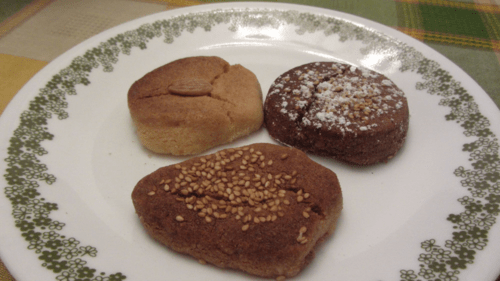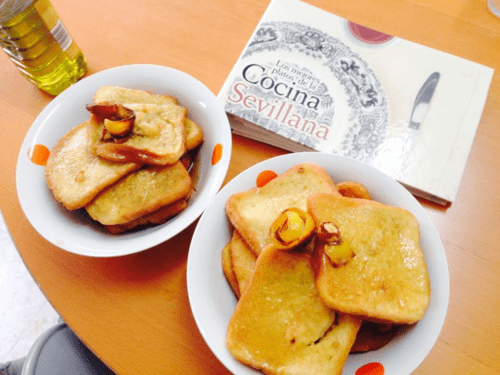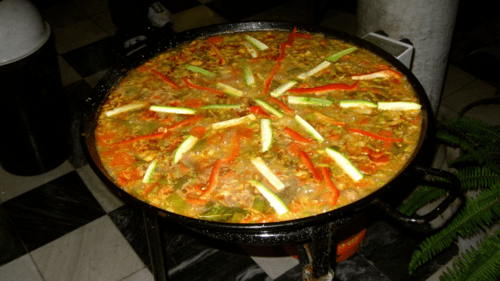Spanish Cuisine
Come one, come all to the land of paella, ham, olive oil, and much more! Spain is rich with delicious food in all forms-appetizers, main courses, and desserts. You will not go hungry here! In this post, I decided to share with you some of the most famous dishes in Spain/Andalusia region. I hope that you will enjoy and maybe try your hand at one of them in the future. (You bet I will!)
**I chose these recipes off of the Internet, and put the website where I got them at the very end. Feel free to look around for other recipes that you might like….these are just starting blocks!**
Salmorejo:
This is a cold, tomato soup, normally made in the summer when it is, of course-hot! (Especially popular in Andalusia)
Ingredients:
- 6 tomatoes, coarsely chopped
- 2 cloves garlic, chopped
- 1/4 cup sherry vinegar
- 1 cup extra virgin olive oil
- 1 tablespoon salt
- 2 day-old country-style bread rolls, about 3 ounces each, torn into pieces and soaked into 1 cup water for 10 minutes, or 2 fresh rolls, torn into pieces
- 1 egg yolk (optional)
- 3 hard-boiled eggs, peeled and finely chopped
- 3 ounces Spanish ham, finely chopped
Preparation
In a large bowl, combine the tomatoes, garlic, vinegar, olive oil, salt, and soaked bread and any remaining water (or fresh bread) and mix well.
Working in batches if necessary, add the tomato mixture to a blender or food processor and process at high speed until smooth. For an specially smooth texture, pass the pureed mixture through a food mill fitted with the medium plate, and then, if desired, return it to the blender or processor, add the egg yolk, and process until thoroughly incorporated.
Transfer to a bowl, cover, and refrigerate for at least 4 hours, or until well chilled.
Just before serving, taste the soup and adjust the seasoning with salt. Ladle into chilled soup plates, garnish with the chopped eggs and ham, and serve.
From: http://www.spain-recipes.com/salmorejo.html
Tortilla de Patatas:
This is a thick, dense mix of potatoes and egg, usually eaten as a tapa or for dinner. (I personally have never been able to finish one-I’m full after eating half!)
Ingredients:
- 6-7 medium potatoes, peeled
- 1 whole yellow onion
- 5-6 large eggs
- 2-3 cups of olive oil for pan frying
- Salt to taste
Prep Time: 10 minutes
Cook Time: 25 minutes
Total Time: 35 minutes
Yield: 6 Servings Main Dish
Preparation:
This tortilla espanola or tortilla de patata makes 8-10 servings as an appetizer, or 6 servings as a main course.
Cut the peeled potatoes in half lengthwise. Then, with the flat side on the cutting surface, slice the potato in pieces approximately1/8" thick. If you slice them a bit thick, don’t worry – it will simply take a bit longer for them to cook.
Peel and chop the onion into 1/4" pieces. Put potatoes and onions into a bowl and mix them together. Salt the mixture.
In a large, heavy, non-stick frying pan, heat the olive oil on medium high heat. Carefully place the potato and onion mixture into the frying pan, spreading them evenly over the surface. The oil should almost cover the potatoes. You may need to turn down the heat slightly, so the potatoes do not burn.
Leave in pan until the potatoes are cooked. If you can poke a piece of potato with a spatula and it easily breaks in two, your potatoes are done. Remove from the pan with a slotted spoon or spatula and allow oil to drain.
Crack the eggs into a large mixing bowl and beat by hand with a whisk or fork. Pour in the potato onion mixture. Mix together with a large spoon.
Pour 1-2 Tbsp of olive oil into a small, non-stick frying pan (aprox. 9-10”) and heat on medium heat. Be carefulnot to get the pan too hot because the oil will burn - or the tortilla will! When hot, stir the potato onion mixture once more and “pour” into the pan and spread out evenly. Allow the egg to cook around the edges. Then you can carefully lift up one side of the omelet to check if the egg has slightly “browned.” The inside of the mixture should not be completely cooked and the egg will still be runny.
When the mixture has browned on the bottom, you are ready to turn it over to cook the other side. Take the frying pan to a sink. Place a large dinner plate (12”) upside down over the frying pan. With one hand on the frying pan handle and the other on top of the plate to hold it steady, quickly turn the frying pan over and the omelet will “fall” onto the plate. Place the frying pan back on the range and put just enough oil to cover the bottom and sides of the pan. Let the pan warm for 30 seconds or so. Now slide the omelet into the frying pan. Use the spatula to shape the sides of the omelet. Let the omelet cook for 3-4 minutes. Turn the heat off and let the tortilla sit in the pan for 2 minutes.
Slide the omelet onto a plate to serve. If eating as a main course, cut the omelet into 6-8 pieces like a pie. Serve sliced French bread on the side.
If you are serving as an appetizer, slice a baguette into pieces about 1/2 inch think. Cut the tortilla into 1.5” squares and place a piece on top of each slice of bread.
From: http://spanishfood.about.com/od/tapas/r/tortilla.htm
Gazpacho:
This is another cold, summery, tomato soup.
Ingredients
- 10 oz of bread
- 21 oz. of tomato
- 2 cloves of garlic
- 2 onions
- 2 red and green peppers
- 1 cucumber (optional)
- 7 tablespoons of oil
- 2 tablespoons of vinegar
- 1 1/2 tablespoon of water
- Cumin (optional)
Preparation
In a big mortar mash the cumin, the garlic and the soaked bread, in a plastic bowl mix the chopped onion, the chopped tomato, the oil, the vinegar, the salt and the contents of the mortar, mash it with the mixer and add very cold water to mix everything. Add salt and strain it. Keep it in the fridge until served.
Serve with the tomato, the cucumber, the pepper and the toasted bread cut to dices.
Preparation time is 30 minutes. For 4 people.
From: http://www.spain-recipes.com/gazpacho.html
Mantecados:
Famous cookie-like dessert eaten around Christmas time, similar to shortbread. Popular kinds are almond, chocolate, coconut, cinnamon, and lemon.
Ingredients:
- 2 1/4 cups vegetable shortening
- 1 cup vegetable oil
- 1 2/3 cup granulated sugar
- 4 egg yolks
- 2 shot glasses of anise (see note below for substitute)
- 1 lemon peel, grated
- juice from 1 lemon
- 1/2 tsp cinnamon
- 7 1/4 cups unbleached white flour
- 1/2 tsp baking soda
- 1 egg white, beaten for glaze
Preparation:
Substitution Note: Anise-flavored liqueur can be purchased at most liquor stores and some gourmet supermarkets. If you cannot find it in your area, substitute 2 shot glasses of vodka and 1 1/2 tsp of anise extract.
In a very large mixing bowl, use a hand mixer to whip the vegetable shortening with the oil. Add the sugar and mix until smooth. Add the egg yolks, anise, lemon peel, juice and cinnamonand mix together. Add flour and baking soda to mixture, a cup at a time. Be sure to mix well. Dough should be very smooth and soft.
Preheat over to 325 degrees. Using a teaspoon, scoop out a dollop of dough. Form balls about the size of walnuts, using your hands. If dough is too sticky to roll into balls, mix in additional flour (from 1/4 to 1/2 cup). Place balls onto ungreased cookie sheet. Lightly press down on each ball to flatten slightly. Using the beaten egg white, brush on the top of each cookie. Bake cookies until they begin to turn light brown on the bottom edges - about 15-20 minutes.
Let the cookies cool 5 minutes before removing from the cookie sheet, as they are very delicate.
Total time: 40 minutes Yields: 7 dozen 2.5 inch cookies
From: http://spanishfood.about.com/od/dessertssweets/r/mantecados.htm
Torrijas:
Basically, French toast, Spanish style. They are covered in honey and normally eaten as a dessert during Easter.
Ingredients:
- 4-6 slices of stale baguette or white bread*
- 3/4 cup milk
- 1 egg
- vegetable oil for frying, such as canola or corn oil, NOT olive oil
- 1/8 tsp vanilla extract (optional)
- sugar and cinnamon to sprinkle (optional)
- honey to drizzle (optional) – From what I have seen, people put more than just a “drizzle” of honey on top of the torrijas ;)
Prep Time: 10 minutes
Cook Time: 10 minutes
Total Time: 20 minutes
Preparation:
* TIP: If you do not have stale bread on hand, lightly toast the sliced bread so that it dries out enough to soak up the milk and not turn to mush.
Pour the milk into a medium-size mixing bowl. Add the egg and beat together. Add vanilla extract, if desired. Pour enough oil into a large frying to cover the bottom and heat on medium. Be careful that the oil does not burn.
If you are using stale white bread, place one slice in the milk-egg mixture and quickly flip it over with a fork. Make sure that the bowl is next to the frying pan, so you can quickly transfer it from the bowl to the heated pan.
If you use a stale baguette, slices should be at least 1/2 inch thick. If the bread is more than a day old, you may need to soak the bread for 2-3 minutes or more, so that it softens up. Be careful that the bread does not soften so much that it crumbles when you lift it out of the bowl.
Carefully lift the bread out of the mixture and let the excess milk drain before placing the bread in the frying pan. Repeat for each of the other slices.
After 2-3 minutes, check the bottom of the bread. As the slices turn golden, turn each one. You may wish to use a nylon spatula or tongs to turn the slices over. Make sure that you have enough room in the pan to turn the slices.
Remove each piece from the pan and place on a plate. Sprinkle the top with sugar and cinnamon. If you prefer, drizzle (pour) honey over the top. Garnish with fresh fruit and serve immediately.
Note: If the torrijas cool down and you wish to heat them up, place them back in the frying pan on low heat or in a toaster oven at a low temperature. Do not place them in a microwave because this will cause the bread to become rubbery.
From: http://spanishfood.about.com/od/dessertssweets/r/torrijas.htm
Paella:
This is a large rice dish, which you can put practically anything in. Below is just one of the many variations…
Herb Blend:
- 1 cup chopped fresh parsley
- 1/4 cup fresh lemon juice
- 1 tablespoon olive oil
- 2 large garlic cloves, minced
Paella:
- 1 cup water
- 1 teaspoon saffron threads
- 3 (16-ounce) cans fat-free, less-sodium chicken broth
- 8 unpeeled jumbo shrimp (about 1/2 pound)
- 1 tablespoon olive oil
- 4 skinned, boned chicken thighs, cut in half
- 2 links Spanish chorizo sausage (about 6 1/2 ounces) or turkey kielbasa, cut into 1/2-inch-thick slices
- 1 (4-ounce) slice prosciutto or 33%-less-sodium ham, cut into 1-inch pieces
- 2 cups finely chopped onion
- 1 cup finely chopped red bell pepper
- 1 cup canned diced tomatoes, undrained
- 1 teaspoon sweet paprika
- 3 large garlic cloves, minced
- 3 cups uncooked Arborio rice or other short-grain rice
- 1 cup frozen green peas
- 8 mussels, scrubbed and debearded
- 1/4 cup fresh lemon juice
- Lemon wedges (optional)
Preparation:
To prepare the herb blend, combine the first 4 ingredients, and set aside.
To prepare paella, combine water, saffron, and broth in a large saucepan. Bring to a simmer (do not boil). Keep warm over low heat. Peel and devein shrimp, leaving tails intact; set aside.
Heat 1 tablespoon of oil in a large paella pan or large skillet over medium-high heat. Add chicken; saute 2 minutes on each side. Remove from pan. Add sausage and prosciutto; saute 2 minutes. Remove from pan. Add shrimp, and saute 2 minutes. Remove from pan. Reduce heat to medium-low. Add onion and bell pepper; saute 15 minutes, stirring occasionally. Add tomatoes, paprika, and 3 garlic cloves; cook 5 minutes. Add rice; cook 1 minute, stirring constantly. Stir in herb blend, broth mixture, chicken, sausage mixture, and peas. Bring to a low boil; cook 10 minutes, stirring frequently. Add mussels to pan, nestling them into rice mixture. Cook 5 minutes or until shells open; discard any unopened shells. Arrange shrimp, heads down, in rice mixture, and cook 5 minutes or until shrimp are done. Sprinkle with 1/4 cup lemon juice. Remove from heat; cover with a towel, and let stand 10 minutes. Serve with lemon wedges, if desired.
Serves: 8
From: http://www.myrecipes.com/recipe/traditional-spanish-paella-0
Other foods that you can’t cook but are popular in Spain:
Ham:
What would we do if I forgot to add ham to this list? Almost everywhere you look in Spain you will see ham hanging from store windows. To eat it, you cut very thin slices off of the leg and put it on bread or eat it alone. (Fun fact: it takes 2-4 years MINIMUM for the ham to be dried.)
Chorizo:
This is another popular meat in Spain. Many people use it as an appetizer or put it on a bocadillo for lunch.
Related Posts

GAP & HSA: palaces & gastronomy in Écija & Osuna, Sevilla
Our GAP and HSA students got to visit these wonderful towns before they departed back to the States. Ecija is known as the City of Towers. Located in the centre... keep reading

It´s not goodbye, it´s hasta luego
Our GAP program ended last week and althought we are sad to see our participants go, we are extremelly happy to have been able to offer a program that offers... keep reading

Exploring medieval castles in Sevilla
Our GAP students got the opportunity to explore two of the most important towns in the province of Seville: Alcalá de Guadaira and Utrera. Alcalá’s castle is the result of... keep reading



